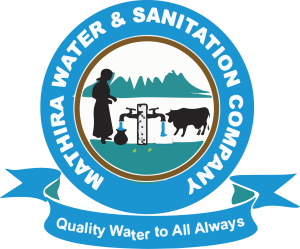Our History
MAWASCO was incorporated in July 2005 under the Kenya Companies Act Chapter 486 and became operational in December the same year when it signed a Service Provisional Agreement (SPA) with Tana Water Services Board (TWSB) now Tana Water Works Development Agency (TWWDA) in line with the Water Act 2002. The company acquired its assets from the Ministry of Water, National Water Conservation and Pipeline Corporation, and also the sewerage system from the defunct Karatina Municipal Council.
The company’s mandate is to provide water and sanitation services to the residents of Mathira East and West Sub-counties (Nyeri County) and environs.
After the transfer of water and sanitation services to the County Governments; the County Government of Nyeri acquired full ownership of the company. Currently, the company is operating under a license issued by Water Services Regulatory Board (WASREB) in line with Water Act (2016).
The company is managed by a Board of Directors drawn to represent various stakeholder organizations. MAWASCO Board of Directors is composed of the Managing Director who represents the Management of MAWASCO on a day-to-day basis. Other directors include representatives from;
![]() Resident/Community Organizations
Resident/Community Organizations
![]() Business Community
Business Community
![]() Professional Bodies
Professional Bodies
![]() Special Interest Groups
Special Interest Groups
![]() Gender
Gender
![]() Farmers Organizations
Farmers Organizations
![]() Commercial Consumers
Commercial Consumers
![]() County Government of Nyeri
County Government of Nyeri
MAWASCOs’ vision is to be a model water and sanitation services provider in Kenya.
The mission of the company is to ensure the provision of quality, affordable, reliable, portable, and sustainable water and sanitation services to all the residents of Mathira East and West Sub-counties in line with the Vision 2030 and the UN Millennium Development goals.
The success of the company in its operating environment is based on its strengths of favorable support from the County Government and other partners, good customer base, engagement of professional staff, the topology of the region that allows for the use of gravity in the distribution of water, elaborate water connection and sewerage system, supportive local community and leaders among others. Not, withstanding our stated strengths, the company faces some key challenges which include: declining levels of river flows, low supply coverage, community water projects, the high number of inactive connections, high Non-Revenue Water (NRW), old dilapidated supply system in the rural scheme and inadequate treatment water and sewer capacity.

